Jurassic World Dominion opened on June 10th this year, once again reminding us just how amazing dinosaurs truly are! As we all know, there are plenty of dinos shown in the films, but it’s sometimes a bit hard to tell which ones we’ve seen before!
Our modern, scientific understanding of dinosaurs comes from generations of research by paleontologists. These explorers of the planet’s past build and share knowledge about prehistoric life by identifying and analyzing fossils.
The creative team behind the film worked with some of today’s paleontologists to develop ideas for dinosaur characters using some species that had not appeared in previous movies. Though the film takes some liberties for the sake of entertainment, the creatures that made it to the screen were influenced by actual scientific research.
Today, we’ve compiled a list of every single dinosaur in the new Jurassic World movie, in case you get a bit curious after watching it. If you are a Jurassic Park/World fan or simply a dinosaur enthusiast, this comprehensive list is perfect for you. Let’s meet every dinosaur featured in Jurassic World Dominion!
A list of every dinosaur featured in Jurassic World Dominion
There are a total of 30 unique dinosaur species in the new Jurassic World movie. Some of them we’ve seen, others we haven’t. We’ve set our list in alphabetical order and included a quick description of the dinosaur, plus the time period they likely lived in here on Earth. It’s easy to forget that these aren’t just movie ideas; these creatures really lived on earth – we have their bones!
Allosaurus

Description: The Allosaurus is one of the most famous dinosaurs in all of the Jurassic movies, as well as one of the most well-known dinosaurs colloquially. The name means “different lizard,” and it was first discovered in the late 19th century in modern-day Colorado.
The Allosaurus was a large bipedal (walked on two legs) predator that measured over 30 feet long and likely weighed between 1,500 and 2,000 lbs. It was among the large carnosaurs, similar to a T-rex.
Time: 155 to 145 million years ago
Ankylosaurus
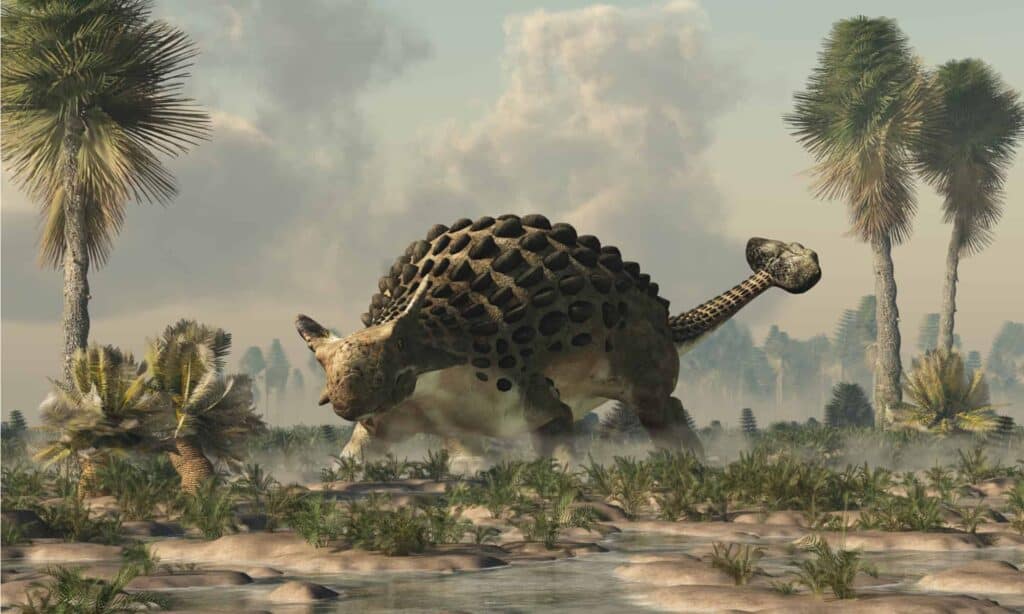
Ankylosaurus had an armored back and club-like tail.
©Daniel Eskridge/Shutterstock.com
Description: The Ankylosaurus is another famous dinosaur that was discovered in western North America. Its name means “fused lizard” and “great belly.” This dinosaur was incredibly heavy and armored. Additionally, it walked on all fours and was primarily an herbivore. Most people would recognize this dinosaur from its heavily armored body and clubbed tail it often used in defense. Ankylosaurus measured up to 20 feet long and weighed as much as 8 tons.
Time: 68-66 million years ago
Apatosaurus
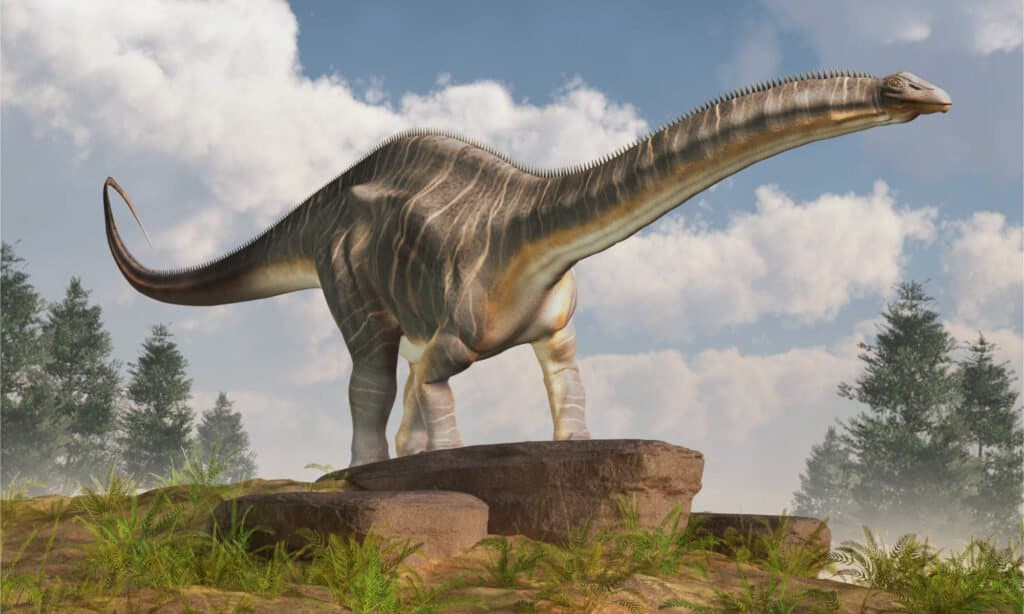
Apatosaurus and other Sauropods had long, whip-like tails.
©Daniel Eskridge/Shutterstock.com
Description: The Apatosaurus was a herbivorous sauropod that walked on all fours. Sauropods are known for their extremely long necks and tails, allowing them to reach tender leaves and ferns. The first Apatosaurus was found in North America. These massive creatures measured between 69 and 75 feet long and weighed between 16 and 22.4 tons, making them one of the larger dinosaurs around.
Time: 152 to 151 million years ago
Atrociraptor
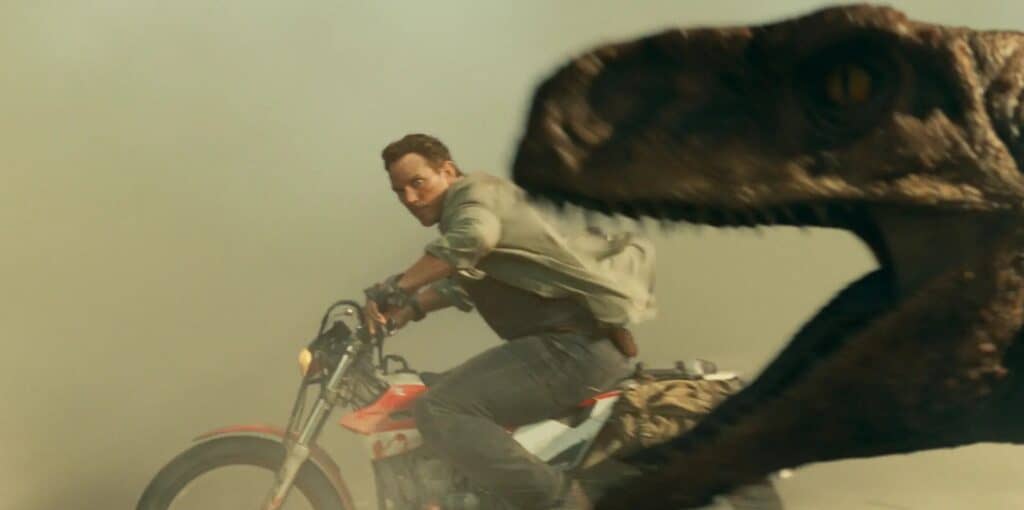
Description: The Atrociraptor was a medium-sized feathered carnivore that walked on two legs. Its name means “savage robber,” and this dino was considered a raptor. The first and only Atrociraptor fragments were discovered in the Horseshoe Canyon Formation in Canada. This raptor measured about 6 feet long and weighed around 35 lbs.
Time: 68.5 million years ago
Baryonyx
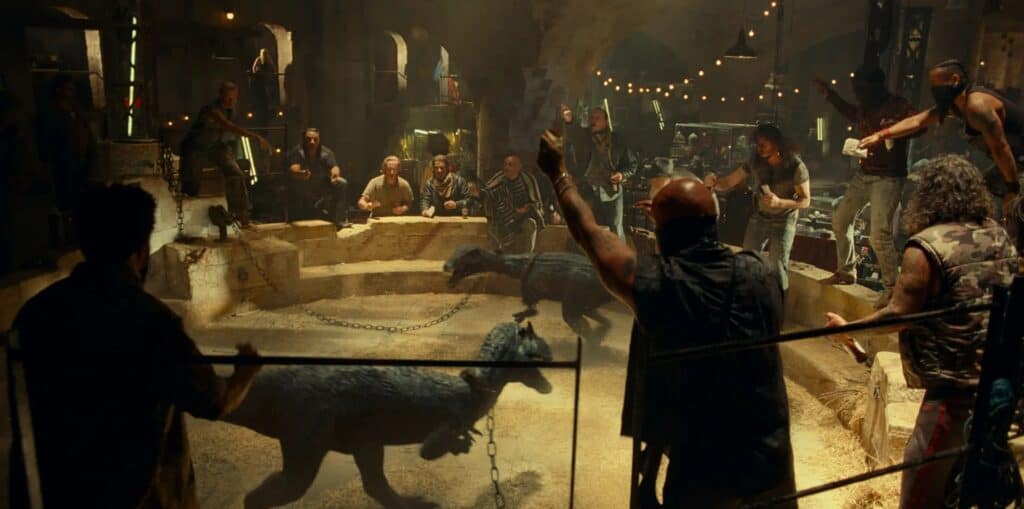
Description: The Baryonyx was a theropod dinosaur that walked on two legs. Its name means “heavy claw,” and it was first found in Surrey, England. Baryonyx was likely piscivorous and could have been semi-aquatic. Most Baryonyx measured between 25 and 35 feet long and weighed between 1.2 and 1.7 tons.
Time: 130-125 million years ago
Brachiosaurus

Brachiosaurus was one of the first dinosaurs seen in the original Jurassic Park.
©iStock.com/dottedhippo
Description: The Brachiosaurus is a famous sauropod that many people know by name (which means arm lizard). Fossil remains were first discovered in the Colorado River, and they lived in modern-day North America. Brachiosaurus had an extremely long neck and tail, measuring between 59 and 69 feet long and weighing between 28 and 58 tons.
Time: 154-150 million years ago
Carnotaurus
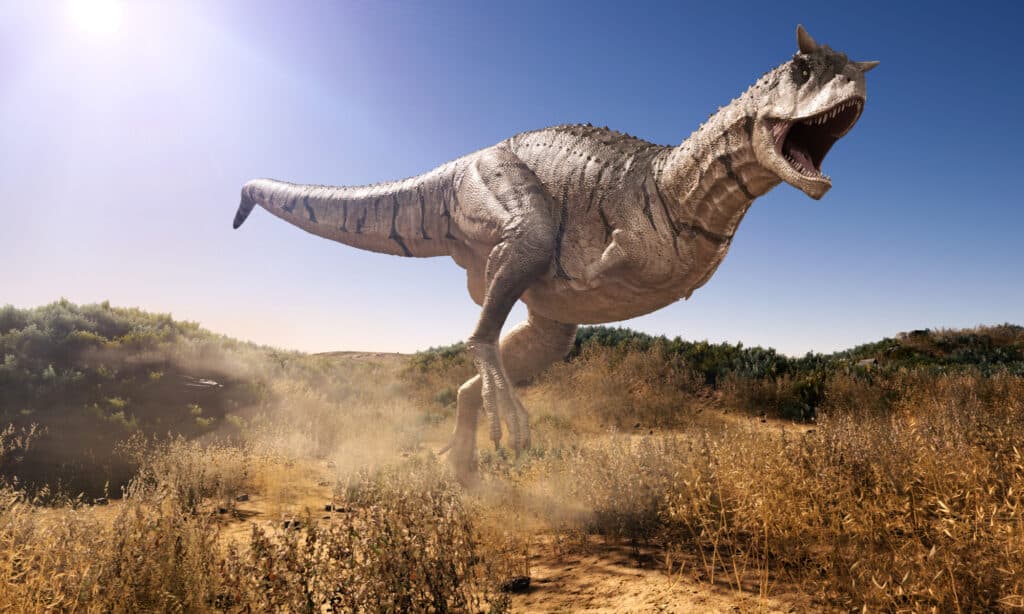
Carnotaurus had thick horns above its eyes, a deep skull, and a very muscular neck.
©Herschel Hoffmeyer/Shutterstock.com
Description: Carnotaurus was a large theropod and bipedal carnivore. Its name means meat-eating bull, which it gets from the large horns it has above its eyes. Fossil remains were discovered at the La Colonia Formation, with these dinos living in modern-day South America. They measured between 24 and 26 feet long and weighed more than 1.3 tons.
Time: 71 and 69 million years ago
Compsognathus

Compsognathus have played a critical role in Jurassic Park films.
©Dotted Yeti/Shutterstock.com
Description: Compsognathus was a small, bipedal carnivore. Its name means elegant, refined, or dainty, as its size shows. Compsognathus remains have been found in Europe, with nearly complete examples found in Germany and France. These dinosaurs were quite small, about the size of a turkey.
Time: 150 million years ago
Dilophosaurus
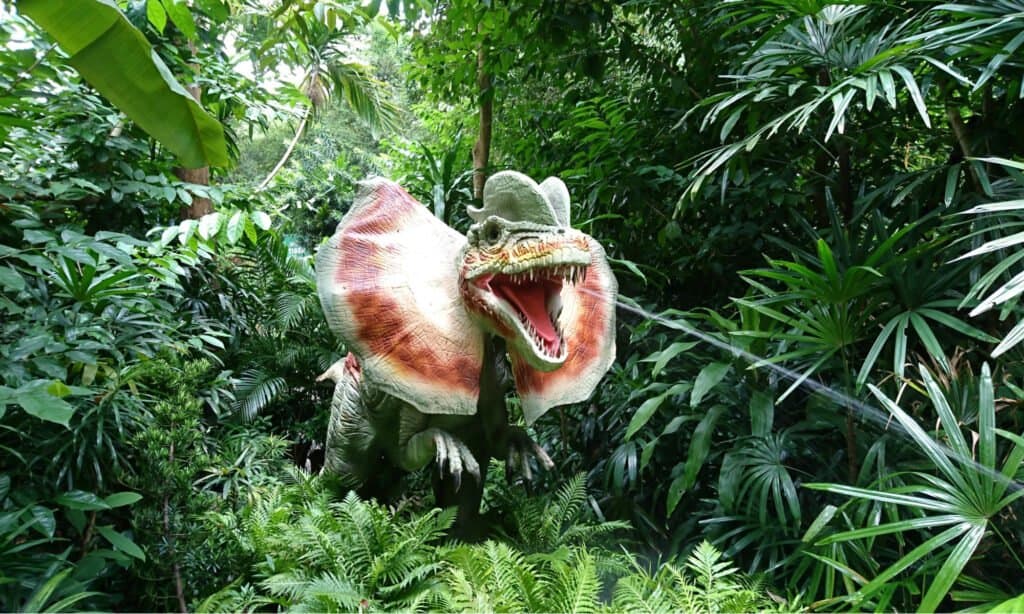
Dilophosaurus makes a return in Jurassic Park Dominion
©Cheng Wei/Shutterstock.com
Description: Dilophosaurus was a medium-sized theropod and one of the earliest large predatory dinosaurs. At the time, it was likely the largest land animal in North America. Its name means “two-crested lizard,” and the first fossils were discovered in Arizona. Dilophosaurus was about 23 feet long and weighed almost 900 lbs.
Time: 193 million years ago
Dimetrodon
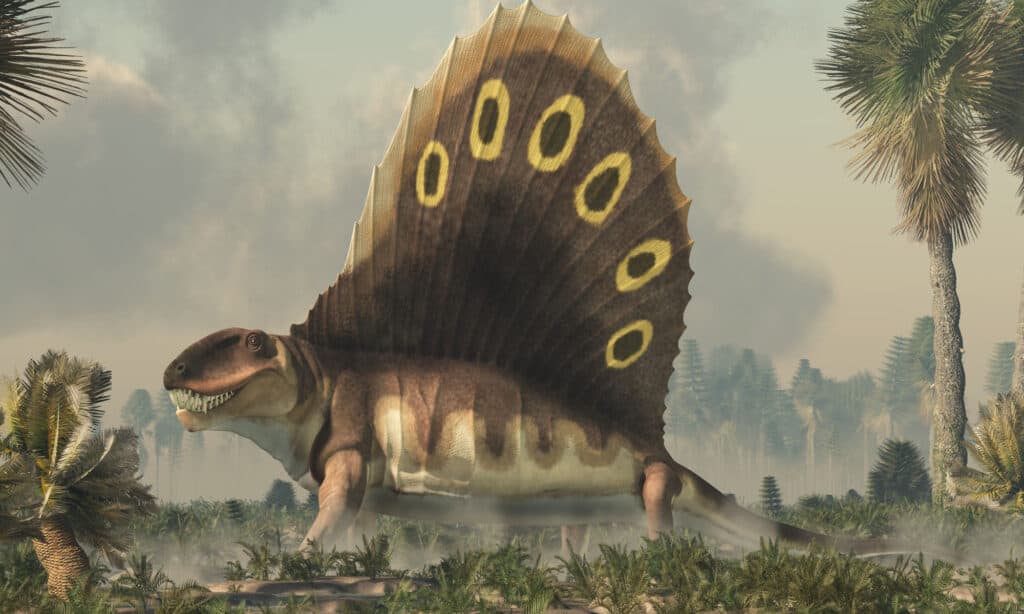
Dimetrodon wasn’t technically a dinosaur.
©Daniel Eskridge/Shutterstock.com
Description: Dimetrodon looks like a dinosaur, although it technically isn’t considered to be one. It is considered a non-mammalian synapsid and died off 40 million years before the first dinosaurs ever lived. Dimetrodon has a large spine sail on its back and likely measured between 6 and 15 feet long and weighed between 60 and 550 lbs.
Time: 295-272 million years ago
Dimorphodon

Dimorphodon had a wingspan of about 4.6 feet.
©Michael Rosskothen/Shutterstock.com
Description: Dimorphodon was a medium-sized pterosaur, classifying it as a flying reptile. Its name means “two-form tooth,” and it was first discovered in England. Dimorphodon was a somewhat smaller dinosaur, measuring 3.3 feet long and having a wingspan of 4.6 feet.
Time: 195-190 million years ago
Dreadnoughtus

Description: Dreadnoughtus was a massive sauropod and a member of the titanosaurian genus, the largest animal on earth before the famous extinction event. Its name means “fears nothing,” as the movie stated, and it was a herbivore. Dreadnoughtus was one of the largest terrestrial animals ever known, measuring around 85 feet long, standing two stories tall, and weighing over 50 tons.
Time: 76-70 million years ago
Gallimimus
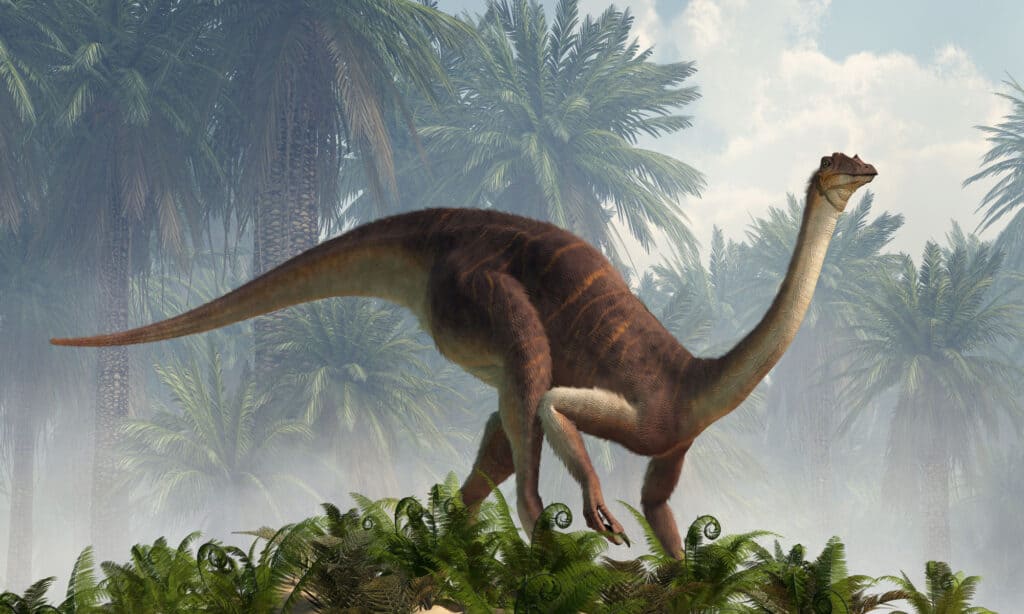
Gallimimus made its appearance in the first Jurassic Park.
©Daniel Eskridge/Shutterstock.com
Description: Gallimimus was a medium-sized, omnivorous, theropod dinosaur. Its name means “chicken mimic” due to how similar its neck is to a chicken’s neck. The first fossils were found in modern-day Mongolia, with evidence pointing towards Gallimimus having been a feathered dinosaur. Additionally, Gallimimus used speed to escape predators and decent intelligence. Gallimimus was about 20 feet long and weighed around 970 lbs.
Time: 70 million years ago
Giganotosaurus
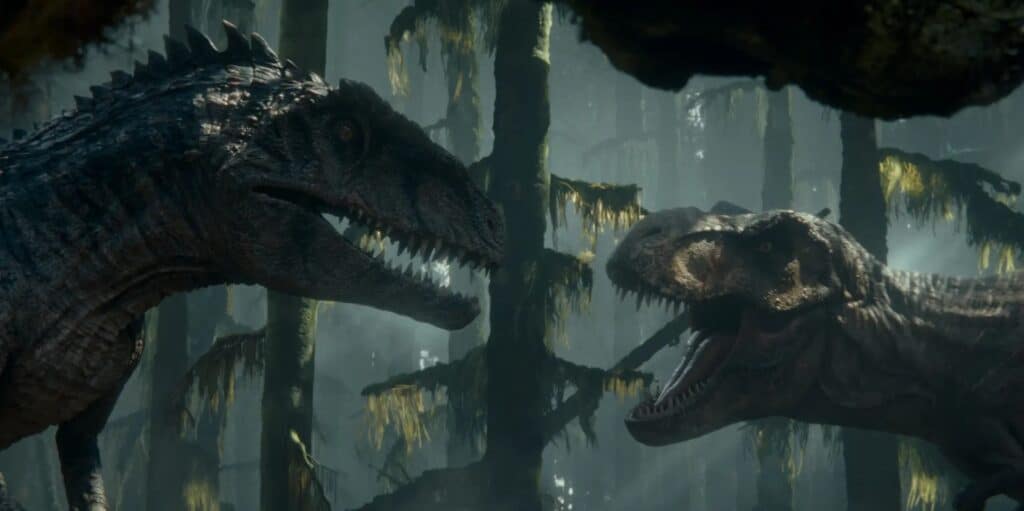
Description: Giganotosaurus was a theropod carnivore that walked on two legs. Its name means “giant southern lizard,” owing to it being found in Patagonia. It is listed as one of the largest terrestrial carnivores, although its exact size has been debated. Giganotosaurus was between 39 and 43 feet long and weighed 4.2-13.8 tons.
Time: 99.6-99.7 million years ago
Lystrosaurus
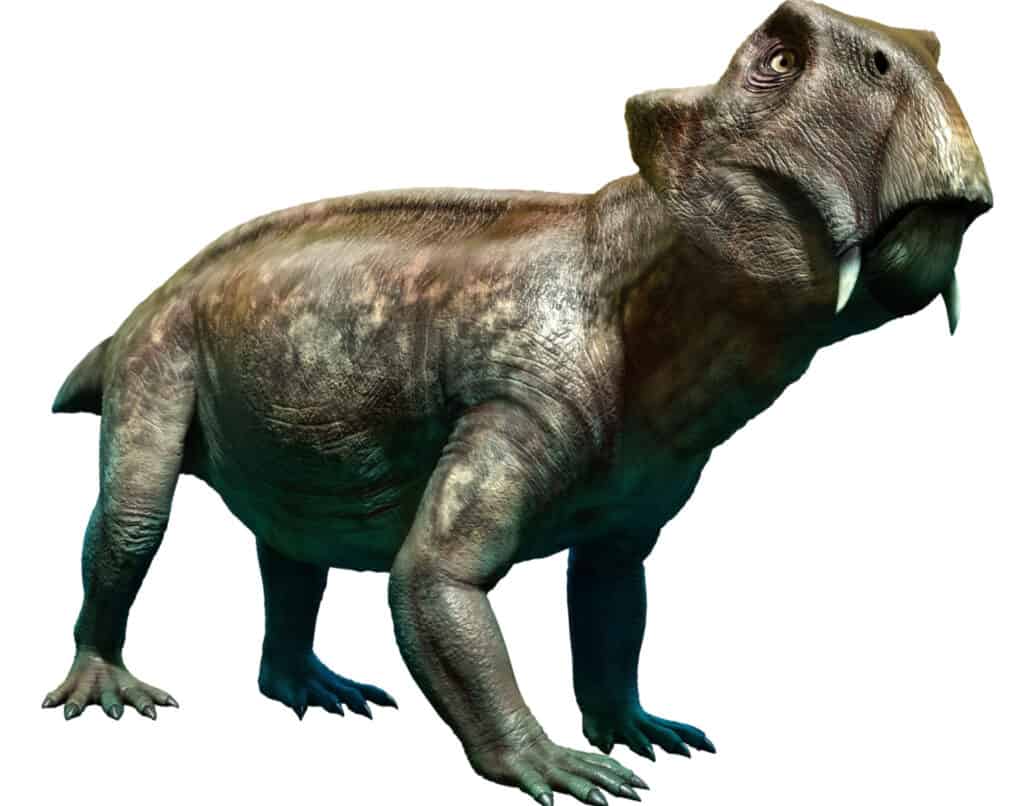
Lystrosaurus was an extremely common animal in its time period.
©Warpaint/Shutterstock.com
Description: Lystrosaurus was a small, herbivorous therapsid (mammal-like reptile). Its name means “shovel lizard,” as it likely burrowed. It is the most common of all terrestrial vertebrates from the period, with over 95% of all fossils in some beds being Lystrosaurus fossils. Lystrosaurus ranged in size, somewhere between a small dog and a pig.
Time: 255-250 million years ago
Microceratus
Description: Microceratus was a small ceratopsian (horned and herbivorous) dinosaur. Its name means “small horned,” owing to its small horns. It was a herbivore and quite small, with the first fossils being found in Mongolia. Microceratus was around 2 feet long.
Time: 90 million years ago
Moros
Description: Moros was a tyrannosauroid (tyrant lizard) theropod dinosaur. Its name means “impending doom,” and it was a smaller carnivore. Moros was first discovered in North America, where it was the earliest known tyrannosauroid from the region. Moros was around 8 feet long and weighed 172 lbs.
Time: 96.4 million years ago
Mosasaurus
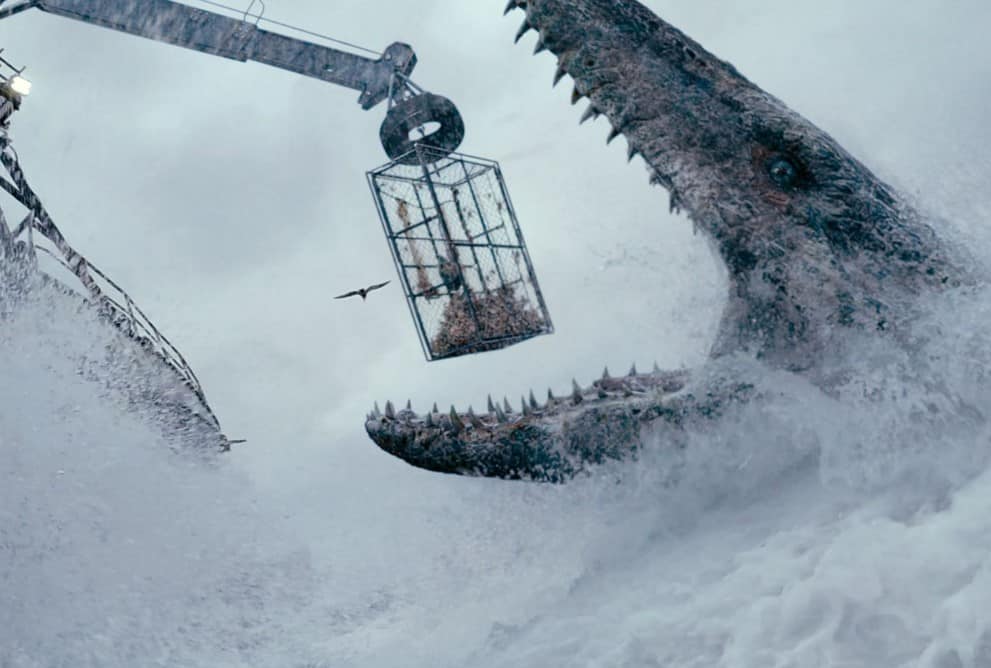
Description: Mosasaurus was a massive aquatic dinosaur and the largest of its species. Its name means “lizard of the Meuse River,” where it was first found. Mosasaurus are estimated to have been 46 feet long and weighed over 13 tons.
Time: 82.7-66 million years ago
Nasutoceratops

Description: Nasutoceratopsis is a large beaked herbivore group that closely resembles triceratops. Its name means “large-nosed” and “horned-nose.” The first fossils were found in southern Utah in the United States. Nasutoceratops were around 15 feet long and weighed 1.5 tons.
Time: 75.9-75.5 million years ago
Parasaurolophus

Description: Parasaurolophus was a large herbivorous dinosaur that walked on two legs. Its name means “near crested lizard,” and it became one of the most successful groups of dinosaurs during the period. Fossils were first found in Alberta, Canada. Parasaurolophus was 33-36 feet long and weighed between 2.5 and 4 tons.
Time: 79.6-73.5 million years ago
Pteranodon
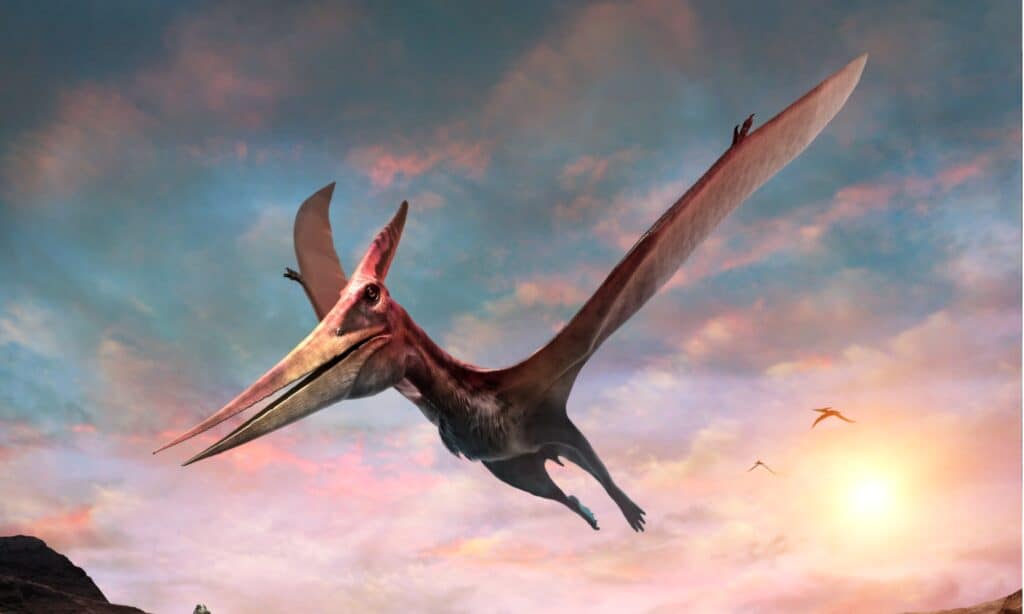
Pteranodon was one of the largest winged reptiles.
©iStock.com/Warpaintcobra
Description: Pteranodon was a group that was composed of the largest flying reptiles ever to live. The name means “wing” and “toothless.” These animals technically weren’t dinosaurs and were composed of about 1,200 species. Pteranodon lived in modern-day North America and had a wingspan of 18 feet, although some specimens show a wingspan of over 23 feet.
Time: 86-84.5 million years ago
Pyroraptor
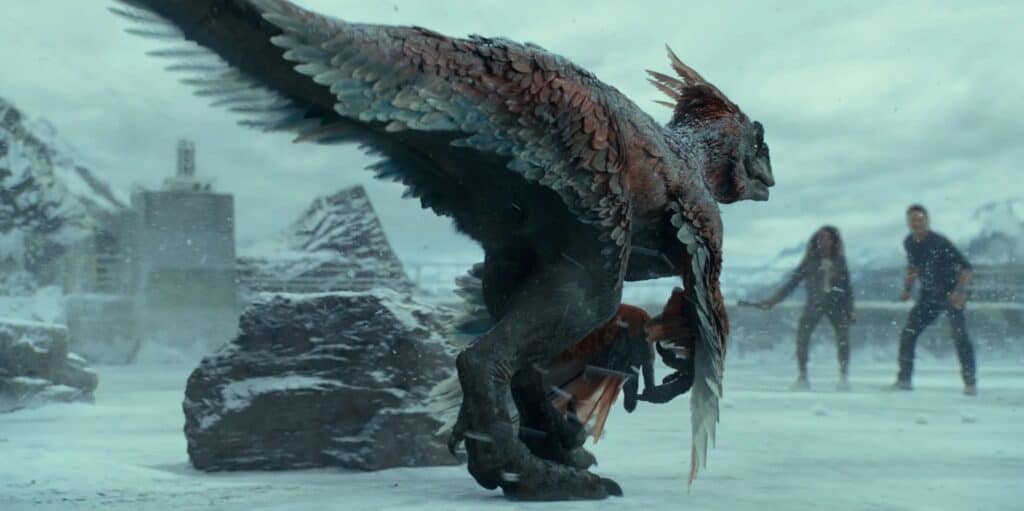
Description: Pyroraptor was a small, bird-like predator that potentially had feathers. Its name means “fire thief,” as it was found after a forest fire. The fossil was discovered in modern-day France, a rare place to find raptor remains, generally. Pyroraptor was small, roughly the size of a turkey.
Time: 70.7 million years ago.
Quetzalcoatlus

Description: Quetzalcoatlus was a pterosaur and was one of the largest known flying animals to have ever lived. Its name comes from the Aztec serpent god, Quetzalcoatl, in the Aztec language. It was first discovered in Texas in 1971 at Big Bend National Park. Quetzalcoatlus had a wingspan that reached well over 50 feet, was 9.8 feet tall, and weighed between 440 and 550 lbs.
Time: 68-66 million years ago
Sinoceratops
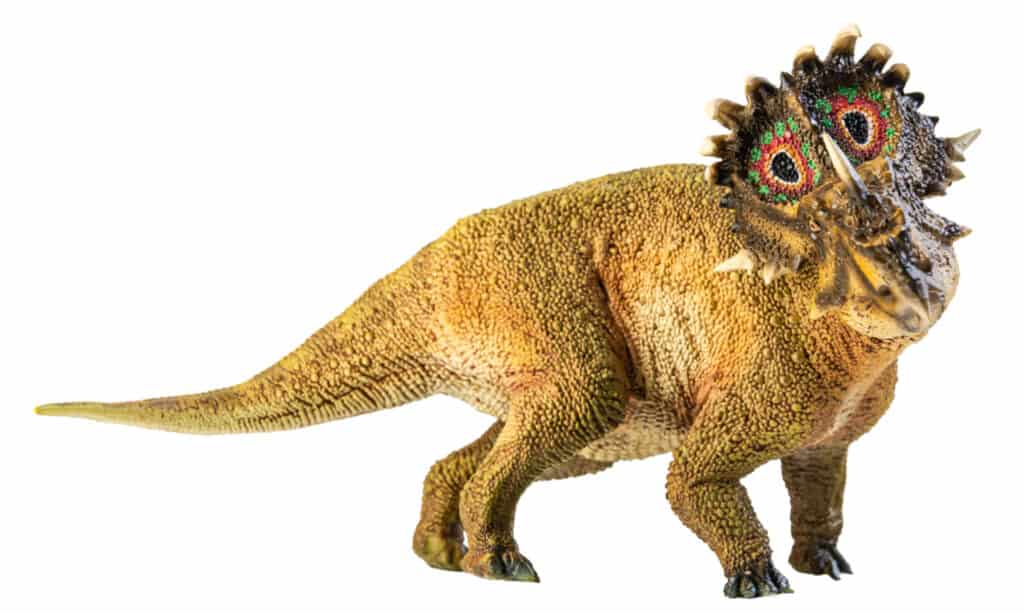
Sinoceratops was about 20 feet in length.
©kamomeen/Shutterstock.com
Description: Sinoceratops was a large ceratopsian (horn-faced) dinosaur. Its name means “Chinese horned face from Zhucheng,” with Zhucheng being the location where fossils were first discovered. Sinoceratops was an herbivore that was 20 feet long and weighed up to 2 tons.
Time: 73.5 million years ago
Stegosaurus
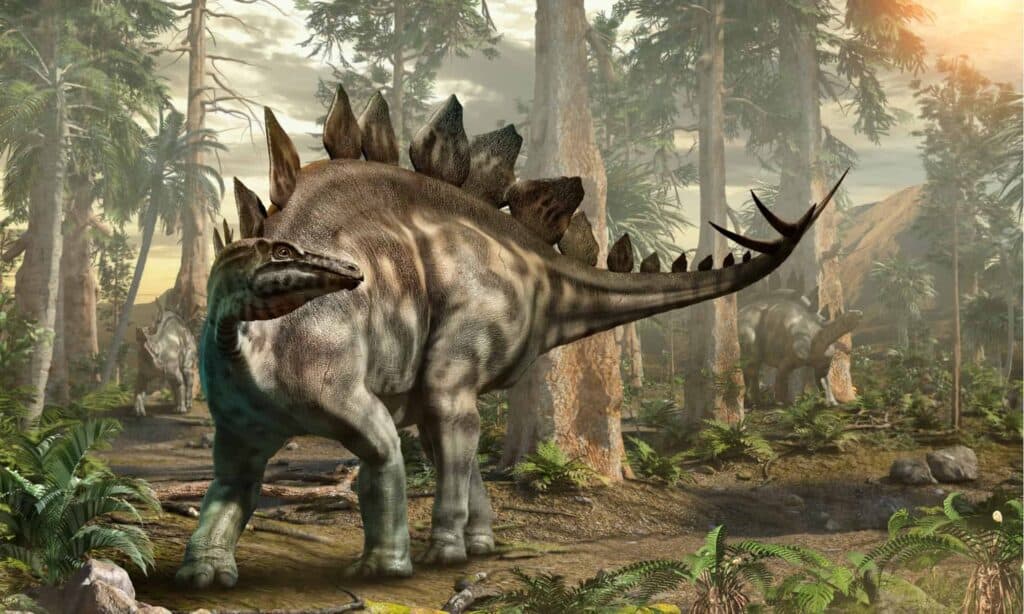
Stegosaurus had distinctive plates across its back.
©Warpaint/Shutterstock.com
Description: Stegosaurus is easily one of the most famous of all dinosaurs around. It was a herbivorous, armored dinosaur that had distinctive plates along its back and tail that were shaped like diamonds. Its name means “roof lizard.” The first fossil remains were found just outside of Morrison, Colorado. Stegosaurus was around 30 feet long and weighed between 5 and 7 tons.
Time: 155-145 million years ago
Stygimoloch
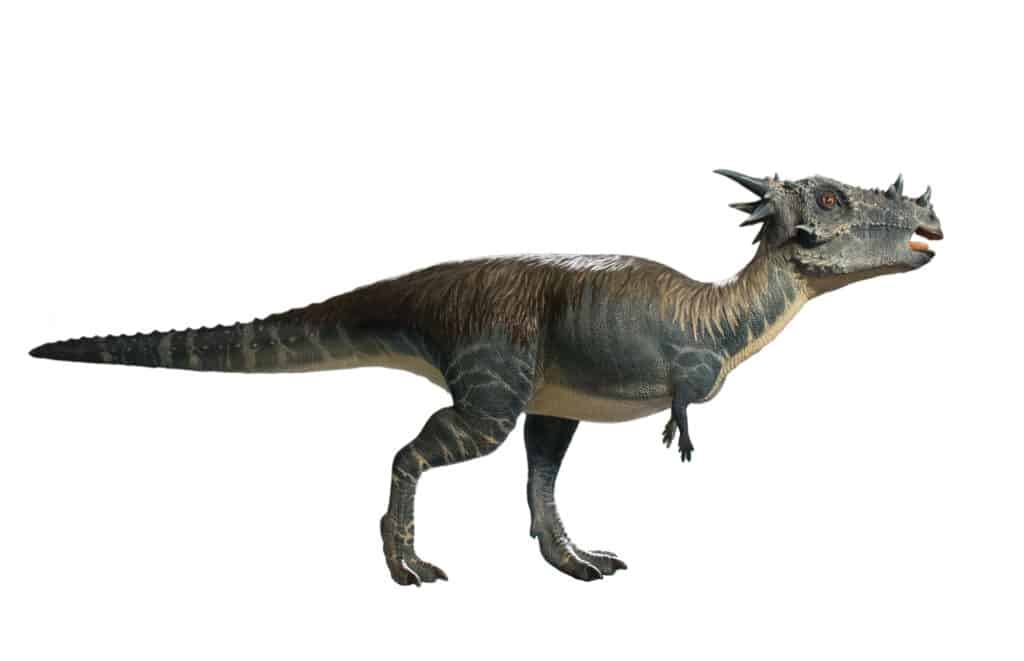
Stygimoloch had a large, bony head
©Noiel/Shutterstock.com
Description: Stygimoloch was a bipedal herbivore that is famous for its thick, bony head. Its name means “demon from the river Styx,” and the species is featured predominantly in a few of the movies. It was first discovered in North America. Stygimoloch was likely 15 feet long and weighed around 1000 lbs.
Time: 70-66 million years ago
Therizinosaurus

©Herschel Hoffmeyer/Shutterstock.com
Description: Therizinosaurus was a large therizinosaurid and one of the primary antagonists in Jurassic World Dominion. Its name means “scythe lizard,” as it had long, sharp claws on its forelimbs. The first specimens found were located in the Gobi Desert in Mongolia. Therizinosaurus was 30-33 feet long and weighed over 5 tons. Therizinosaurus is Jurassic World’s newest “nightmare predator.”
Time: 70 million years ago
Triceratops

Triceratops had a long bony frill with three horns on their skull.
©Dotted Yeti/Shutterstock.com
Description: Triceratops was a large, herbivorous dinosaur that many people could recognize by name. Its name means “three horn face,” and it has a large bony frill around its head and three large horns. It was first discovered in Denver, Colorado, as it lived in modern-day North America. It was likely the primary prey of the Tyrannosaurus Rex. Triceratops was around 30 feet long and weighed 10 tons.
Time: 68-66 million years ago
Tyrannosaurus

©Herschel Hoffmeyer/Shutterstock.com
Description: Tyrannosaurus is easily the most famous dinosaur to have ever lived. These bipedal carnivores were the last members of the tyrannosaurids before the large extinction event. Tyrannosaurus rex means “king of the tyrant lizards” and is quite apt. The first fossil was first discovered in Golden, Colorado. Tyrannosaurus was around 40 feet long and weighed 14 tons.
Time: 68-66 million years ago.
Velociraptor

Description: Velociraptors were a group of small carnivorous theropods. The name means “swift seizer” due to their speed. Despite their immense fame, primarily due to the movies, Velociraptors were roughly the size of a turkey and had feathers. Most of the “Velociraptors” in the movies are based on members of the Deinonychus genus. Velociraptors were first found in the Gobi Desert in Mongolia.
Time: 75-71 million years ago
10 Facts about Dinousous Listed in The Jurassic World Dominion Movie
The Jurassic World Dominion movie, which was released in 2022, features several species of dinosaurs that were recreated through genetic engineering.
Here are 10 interesting facts about the dinosaurs listed in the movie:
- Indominus Rex: This hybrid dinosaur was created by combining the DNA of multiple species, including the T. rex, Velociraptor, and Cuttlefish.
- Stegosaurus: This dinosaur is known for its distinctive plates on its back and tail, which were used for protection and thermal regulation.
- Triceratops: This herbivore was one of the largest dinosaurs, and its three horns were used for self-defense.
- Velociraptor: This carnivorous dinosaur was fast and agile, and its long claws were used for hunting.
- T. rex: The T. rex is one of the most famous dinosaurs and was one of the largest carnivorous dinosaurs that lived during the late Cretaceous period.
- Ankylosaurus: This dinosaur was heavily armored and had a club-like tail that was used for self-defense.
- Pterosaurs: These flying reptiles were not dinosaurs but were contemporaneous with them.
- Mosasaurus: This marine reptile was a large predator that lived in the oceans during the late Cretaceous period.
- Brachiosaurus: This dinosaur was one of the tallest dinosaurs and had a long neck that allowed it to reach high trees.
- Parasaurolophus: This herbivorous dinosaur was known for its distinctive cranial crest that may have been used for communication and attracting mates.
These dinosaurs and others in the Jurassic World Dominion movie provide a glimpse into the diversity of life that existed during the Mesozoic Era. They are a testament to the ingenuity of genetic engineering and the power of imagination.
The photo featured at the top of this post is © Herschel Hoffmeyer/Shutterstock.com
Thank you for reading! Have some feedback for us? Contact the AZ Animals editorial team.






